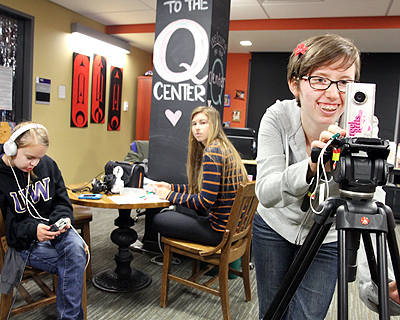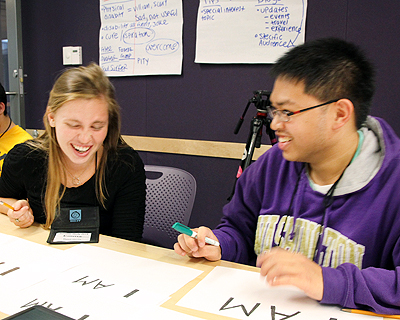AccessDesign
With funding from the Institute for Human Centered Design, the DO-IT Center at the University of Washington offered resources and workshops as part of a pilot project called Access to the Design Professions for People with Disabilities (AccessDesign). The goal of AccessDesign was to increase the pipeline of design professionals with disabilities by expanding the recruitment and support of students with disabilities into postsecondary design education and increase the engagement of professionals in the field.

Design Careers and Students with Disabilities
For students with disabilities interested in a creative career path, design fields—such as architecture, interior design, apparel design, landscape architecture, and graphic design—offer many opportunities. Practitioners in these fields experience the satisfaction of seeing their ideas turn into objects, buildings, or websites.
Design Fields
There are many types of design majors and careers that you might consider pursuing. Below is just a small sampling of the sorts of opportunities available.
- Architecture. Architects use technical knowledge and artistic creativity to design small and large spaces--from home remodel projects to shopping malls to skyscrapers.
- Landscape Architecture. Landscape architects work with plants, bushes, trees, and structures, including natural and man-made objects.
- Interior Design. Interior designers help make a variety of spaces inviting and attractive as well as practical and functional to suit the needs of their clients.
- Apparel Design. Apparel designers combine technical knowledge, precision, and an artistic eye to make clothing, footwear, and other garments.
- Industrial Design. Industrial designers create many kinds of everyday products from household items to electronics to vehicles with consideration to aesthetics, ergonomics, and usability.
- Web Design. Web designers use a mix of technical skills; design elements such as type, images, and color; and usability knowledge to create websites. Graphic Design. Graphic designers communicate ideas visually through effective use of words, symbols, and images. Graphic designer’s work can be used in many mediums including print, web, product packaging, and signage.
- Urban Planning. Urban planners develop cities, taking into account issues such as affordable housing, public transportation, the environment, land use and zoning, and economics.
Why should students with disabilities consider studying design fields?
Design fields offer multiple, interesting career options that allow you to be creative, develop technical skills, and see your ideas turn into reality. Designing buildings, planning cities, or creating websites offer students opportunities to improve the world around them. Moreover, by being designers, individuals with disabilities can help to make the world more welcoming and accessible to other individuals with a wide variety of disabilities.
According to the Institute for Human Centered Design’s publication Building a World Fit for People: Designers with Disabilities at Work, design itself is improved when individuals with disabilities participate as designers. Designers with disabilities found that “living with a disability while thinking about improving designed spaces had heightened their thoughtfulness, determination, maturity, problem-solving skills, empathy, aesthetic consciousness, kinesthetic awareness, and social justice in design.” An important skill that individuals with disabilities often bring to a career in design is many years of practice in developing creative approaches to maneuvering through the physical environment, using technology, and otherwise actively engaging in personal, academic, and community activities.
What can I do to be successful studying in a design field?
To be successful studying a design field, plan ahead, attend college, be pro-active in school, and prepare to move beyond college and into your career.
- Explore options. Learn about majors and career fields that you might be interested in pursuing. Determine what career options are available to you with an associates, bachelors, or masters degree. When looking at specific programs, ask whether the instructors/professors are practicing design professionals and what sorts of careers their graduates have gone on to. Seek advice from family members, teachers, school counselors, and career guidance counselors when making decisions about choosing a direction that is best for you. Career services offices at your school may offer classes, testing, and consulting in these areas.
- Pay attention to entrance requirements. While in high school, participate in college fairs at your school or in your community to meet college representatives in person. Look at the websites or call the institutions that you hope to attend to find out about entrance requirements for schools and for particular design majors.
- Choose a program carefully. Some design fields require completion of an accredited program to obtain a license to practice. Not all postsecondary institutions will have an accredited program, so pick carefully.
- Establish a timeline. Establish a timeline that includes deadlines for college applications and financial aid paperwork as well as your schooling. Determine how long your education will take. Some design programs take five years to earn a bachelors degree. Find support services. Resources are not the same at each postsecondary institution. Knowing your needs and how they can be met is an important factor when selecting a college. Contact the disability services office at campuses of interest to see if they offer the accommodations and support that you require. Ask what type of disability-related documentation the college requires to provide requested services. Ask specifically about accommodations for courses in your major for barriers presented by studio classes, software, or fieldwork and field trips. Arranging support services can take a long time depending on the services you need and the resources that are available. Be sure to allow enough time before school begins to submit your documentation and accommodation requests.
- Develop and apply self-advocacy skills. Self-advocacy skills include knowing how to skillfully initiate action and interact with faculty, staff, and other students to obtain support services necessary for your learning needs. You are the one who must recognize your needs, as well as mainstream services and disability-related accommodations, that will help you be successful. Make contact with those who can provide support or allow accommodations, follow-up on these contacts, and meet any requirements to receive the services needed.
- Develop and apply self-management skills. Take into account your abilities and strengths, as well as your disabilities, when scheduling classes, work, and social activities. If your strength and ability vary daily, allow for flexibility. Self-management skills include maintaining reasonable academic and personal routines on a daily basis.
- Develop good study skills. Study skills involve knowing how you can effectively learn academic content. These skills include strategies for note-taking during lectures and studios, reading, and test-taking. Development of each of these skills is important and leads to effective overall study habits. On many campuses, study skills courses are available to students free of charge. Many campus departments have tutoring, study groups, and open labs to help students be successful. Thoroughly explore the availability of these offerings at your school and take advantage of opportunities available to you.
- Use technology effectively. Use of computer and Internet resources is often essential in design education and careers. Assistive technology makes it possible for people with a variety of disabilities to use these tools. Take advantage of opportunities to learn about and use computer technologies. Many colleges have computer labs available to students that provide assistive technology. Find out what technology is available at your school and make use of these resources.
- Network. Throughout the process of preparing for and attending college, conversations, interactions, and assistance from a broad range of people will likely take place. Take advantage of networking opportunities through the career center, professional organizations, friends, family, and coworkers because who you know, as well as what you know, can determine your success.
- Build your résumé. To begin building a résumé, make a list of all of your relevant work experiences (paid and volunteer), academic experiences, and other activities. Seek advice from campus career advisors and consult print and online resources as you select the best style and format for your résumé. Participate in work-based learning. The career services office at your postsecondary institution may offer employment, cooperative, and internship opportunities in design fields. If opportunities are not available, make efforts to obtain other work-based learning experiences for your résumé. These experiences can also help you confirm your area of interest and career path, as well as establish a network of contacts, that will be needed for post-college employment. You may also seek out volunteer opportunities on campus or beyond that allow you to practice your design skills.

Where can I find more information about design careers?
- American Institute of Architects
- American Institute of Graphic Arts
- American Planning Association
- American Society for Interior Designers
- American Society of Landscape Architects
- Building a World Fit for People: Designers with Disabilities at Work
- Council of Fashion Designers of America
- Industrial Designers Society of America
- Institute for Human Centered Design’s Access to Design Professions
- Web Designers and Developers Association [NOTE: This organization no longer exists.]
Consult the following resources for more information related to individuals with disabilities and design fields:
- AccessDesign: A Promising Practice for Students with Disabilities Exploring Design Careers
- Andrea and Computer Modeling: A Case Study on Drawing and Modeling in Architecture
- Are there e-mentoring programs to support students with disabilities interested in careers in design fields?
- Design Careers and Students with Disabilities
- How can I make a design studio class more accessible to students with disabilities?
- Observation Requirements for New Interns: A Case Study on Field Work in Architecture
- Why should students with disabilities consider studying design fields?
Primary funding for DO‑IT is provided by the National Science Foundation, the State of Washington, and the U.S. Department of Education. This material is based upon work supported by the National Science Foundation under grant#HRD-0833504 and by the Institute for Human Centered Design. Any opinions, findings, and conclusion or recommendations expressed in this material are those of the author and do not necessarily reflect the views of the National Science Foundation.
AccessDesign was developed through a partnership between The Alliance for Students with Disabilities in Science, Technology, Engineering, and Mathematics (AccessSTEM, Research in Disabilities Education award #HRD-0833504) and Access to Design Professions, Institute for Human Centered Design (IHCD), Boston, MA and funded in part by a grant from the National Endowment for the Arts (NEA).